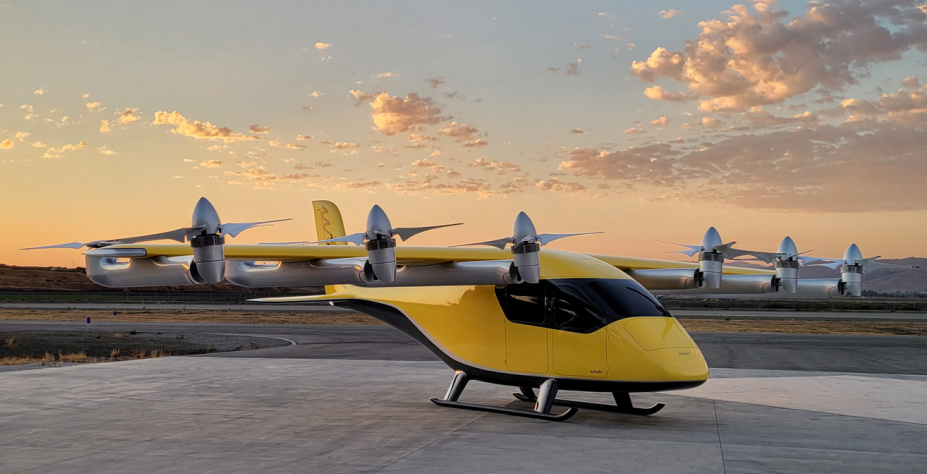
Wisk’s air taxi is designed to carry four passengers up to 90 mi. at a cruise speed of 110-120 kt.
While most air taxi startups are pursuing a piloted vision for urban air mobility (UAM), Boeing subsidiary Wisk Aero is staking its future on a fully autonomous aircraft from the outset.
This amounts to a high-stakes bet that regulations and public acceptance will come together to enable a successful commercial launch in the not-too-distant future.
As part of the company’s vision for unmanned, on-demand flight services, aircraft would be monitored by so-called multivehicle supervisors, employees of Wisk who would track them from company ground control stations. But how much responsibility do those remote supervisors really hold, and how busy will they be trying to simultaneously manage multiple aircraft?
The answer, surprisingly, is they likely will “not be doing much at all,” explains Jonathan Lovegren, Wisk’s chief of autonomy and airspace integration, in an interview with the AAM Report.
“When things are working fine and there’s no emergencies, they’re doing very little, and that’s very necessary because when you’re controlling five or 10 or possibly more aircraft at a time, there is only so much you can do on an individual aircraft basis,” Lovegren says.
“The kinds of things they will be doing could involve approving the aircraft for takeoff, maintaining situational awareness, tracking weather and maybe some communications role with ATC [air traffic control],” he adds. “But besides those types of functions, we don’t anticipate a whole lot of direct interaction with the supervisors early on.”
The vehicle supervisors are different than remote pilots, as they will be unable to manually take control of the aircraft and remotely pilot it at any time, even during an emergency. But the aircraft’s systems have also been designed to automatically trigger the autoland function when there is a critical problem with the propulsion or flight systems, so the supervisor would never have to step in to manually direct the aircraft when a problem arises, Lovegren explains.
“We designed this aircraft so we are not dependent on the response time of the operator or that person’s ability to think quickly under stressful conditions,” Lovegren says, observing that human pilot error factors into a large majority of accident sequences tracked by the National Transportation Safety Board.
“We’re not expecting the person to step in and do something in an emergency. We actually think that introduces more risk,” Lovegren said. “In any case, where we have something fail that is essentially critical to the flight safety, and we need to get to the ground sooner, we’ll have mechanisms in place to trigger that [landing] automatically so we’re not waiting on the response of any human operator.
“Generally speaking, people are not great at going from relaxed states to being engaged in extremely involved activities on the fly,” Lovegren adds. “We don’t want our operators to go from a relaxed supervisory environment to suddenly being a fighter pilot during an emergency. That doesn’t make for a good human factors situation.”
Wisk envisions each vehicle supervisor monitoring three vehicles at entry-into-service, eventually scaling to five, eight, or even 10 or more aircraft per controller as operations mature. Manual touchpoints that slow down operations, like calling in individual takeoffs over radio to ATC, can be reduced or eliminated in collaboration with the FAA to enable greater scale over time, Lovegren says. He adds that technology and regulations will have to evolve in tandem to unlock maximum scale.
“There are going to be multiple things that prevent us from scaling that supervisor-to-vehicle ratio up in the beginning, on both the technology and the procedural and regulatory sides, but we expect all these things to evolve over time,” he says.
Wisk is the only major air taxi startup that is designing its vehicle to be fully autonomous from the outset, whereas competitors like Archer Aviation and Joby Aviation are designing piloted vehicles with an eye to future design changes to permit autonomy as regulations and public acceptance evolve.
Lovegren acknowledges that Wisk’s approach carries added risk of backfiring in the event that autonomy proves longer than expected to unlock. But he is confident that in the long term, the choice to design for autonomy will prove wise, as other vehicles will require complete redesigns to remove piloted systems–something that Wisk believes is needed for UAM to achieve mass scale.
“It’s a fundamentally different aircraft, designed to different standards, when you remove that pilot,” Lovegren says. “If people expect they can just take a piloted aircraft and one day turn off the pilot controls and make it autonomous, that’s not realistic. It’s a completely different certificate and a different certification program.
“They’re going to have to design an entire aircraft and spend however many billions it requires to take it to market, and then go through a completely new development program before they get to scale,” Lovegren says of competing startups pursuing a piloted-first approach to UAM. “That’s a lot to stomach. So yeah, there’s a potentially shorter path for them to get to first flight, but it’s a much longer path for them to achieve scale and profitability.”




